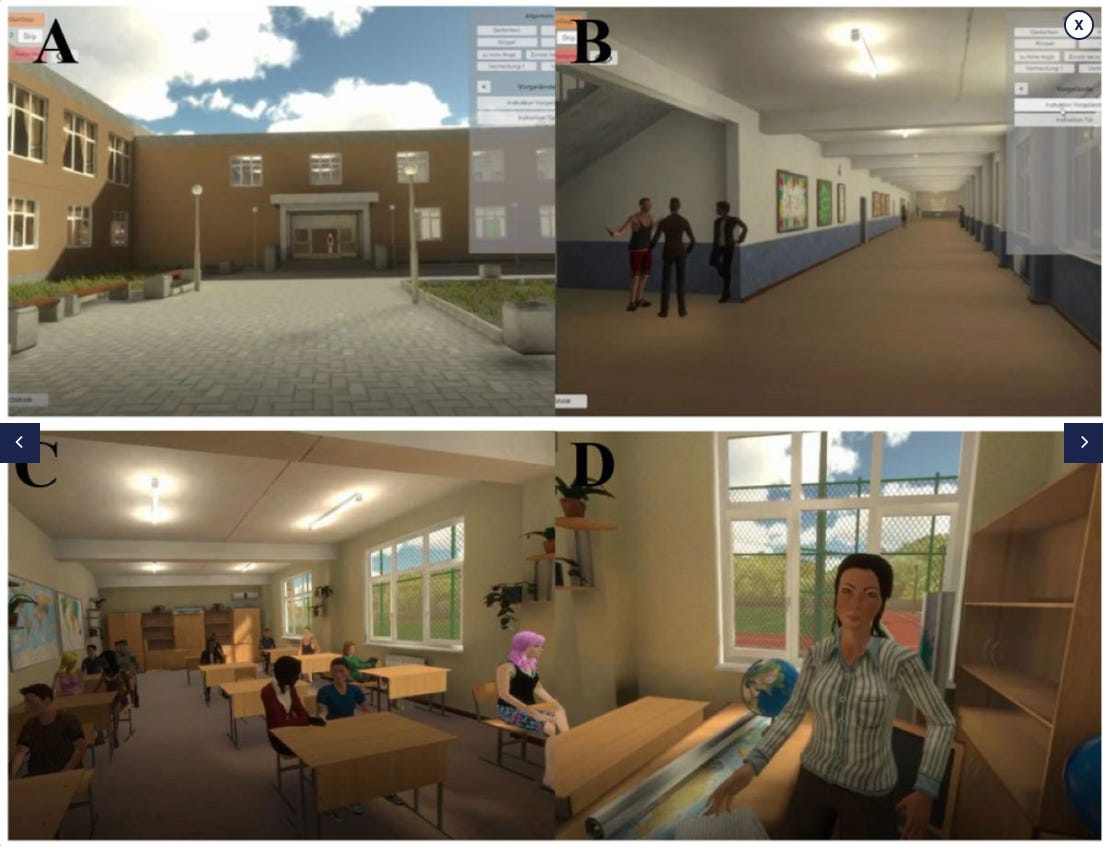This fortnight’s Life on Mars reviews a study looking at the potential of virtual reality to lessen anxiety. I once encountered an early VR forerunner in a run-down coastal theme park called Pleasurewood Hills (neither word scored highly on accuracy). Amidst the spinning teacups, arthritic waltzers and the faint scent of fishy vinegar sat a dome-shaped building that promised to play with visitors’ sense of reality. I was in the horde of hopeful pleasure-seekers who filed into it one summer afternoon in the early 1990s.
The building’s offer was heavy on the virtual and light on the reality: a moving image, filmed from the perspective of somebody riding a rollercoaster, was projected onto the ceiling above and around where we stood. (We’d literally paid money to watch a video of a rollercoaster while standing in a theme park that had rollercoasters in it.)
As the projected rollercoaster cranked itself up to the top of a hill and then paused at the top, the room was still. The image tipped into its inevitable plunge. I stood in smug silence as people around me started to scream. The projected rollercoaster then took on a sideways motion as it careened alarmingly around corners. My complacency came to a swift, humiliating end when my body tried in vain to adjust to what my eyes were seeing. I lent too far away from the direction of a bend and landed sideways on the floor: even terrible facsimiles of virtual reality do strange things to the brain.
VR has become rather more sophisticated since the early 1990s, though my ability to connect false stimuli with material reality has not. The treadmill in my local gym has a screen that allows runners to explore Chicago or the Costa Rican jungle. I can’t use it. If the path twists or shows an upcoming tree root, I stumble.
This fortnight’s Life On Mars looks at a trial of VR exposure therapy on teenagers who feel anxious about going to school, a study on connections between eating disorders and anxiety, and a review of school-led nature interventions.
Facing fears through virtual reality may lessen school anxiety
Study title: Virtual Reality Exposure Therapy for Reducing School Anxiety in Adolescents: Pilot Study (November 2024)
Imagine a teenage boy who feels anxious about school. It could be that he’s been bullied. Perhaps time away from school during Covid set off a chain of negative feelings and reactions. Or maybe the reasons are not obvious. One day, he gets asked to strap on virtual reality goggles and headphones, and is given two controllers that allow him to walk, jump and carry objects in the VR world he is about to enter.
The VR scenario begins. Our teenage boy stands on a street in front of a school, then walks inside. He wanders at his own pace around the buildings and the area outside it. He then goes into a classroom, the normal sounds of a school day filling his ears. The bell rings to mark the start of the lesson. The boy is asked to come to the front of the class and complete three tasks that he finds quite stressful – to introduce himself, to solve a verbal maths problem and to talk about a recent personal experience. The boy then returns to our real-life world, where his feelings are assessed. He repeats this virtual exposure four more times over the next month, at which point the order of the challenges are mixed up and his classmates start to respond to his actions – they look at him, they applaud him or they laugh.
This was the format of a German experiment run with 13 teenagers suffering from school-related anxiety. Researchers measured feelings of anxiety at the start and end of the experiment, looking at teenagers’ general feelings of worry, their fears about exams and their school reluctance – what the researchers termed ‘inner resistance and loss of motivation towards educational matters’. They also looked at current feelings of distress.
Here’s what the experiment didn’t do: it didn’t significantly change the teenagers’ exam-related worries (which isn’t surprising, given there weren’t any exam scenarios), nor their general feelings of anxiety. Their current feelings of distress improved, though, their school reluctance diminished and they became less socially anxious. While the results of the VR exposure were not as successful as cognitive behaviour therapy nor normal exposure therapy in treating school anxiety, the researchers think it holds promise for future interventions. They believe that more VR sessions and including a wider range of scenarios may prove fruitful, as may combining it with other treatments.
The quality of this study was low. The sample size was tiny. The image above shows that the sophistication of the images was somewhat lacking. We don’t know if there are unintended consequences of asking teenagers, repeatedly, how anxious they are feeling. With no comparison group, there’s a possibility that any positive changes result from being exposed to supportive adults who clearly want to help the teenagers with their distress. We could have greater confidence in the results if the study had compared outcomes with a group of teenagers who had VR sessions using a different scenario – perhaps paddling gently down a river on a kayak – and we’d still seen more positive changes in those exposed to school.
We know that exposure therapy works. As Dr Brian Zaboski of Yale School of Medicine has put it, ‘By confronting their fears, students challenge anxiety-based cognitions (e.g., “If I speak in front of the classroom something terrible will happen”) and develop new neural connections that inhibit existing fear pathways.’ If a teenager is worried about school to the extent that he or she doesn’t want to go, exposure to school is likely to help, while avoidance is likely to do the opposite. VR may be a safe way to test the waters for those whose fears have built up so much that they feel insurmountable. In the end, though, a supported, real-life return to the classroom can be the only fix.
Anxious teenagers are more likely to develop eating disorders, and teenagers with eating disorders are more likely to become anxious
Study title: The Prospective Relationship between Anxiety Symptoms and Eating Disorder Symptoms among Adolescents: A Systematic Review and Meta-Analysis of a Bi-Directional Relationship (November 2024)
Teenagers with eating disorders often have symptoms of anxiety at the same time. Researchers conducting this review of studies set out to discover the nature of this relationship – is feeling anxious linked to later development of eating disorders, or is the link the other way around? (If the researchers were less cautious, they might have framed this question around causation – does anxiety cause eating disorders, or does having an eating disorder make sufferers feel anxious? The researchers were rightly careful, as any relationship may be driven by something else entirely – unhappiness at school, for example – but a causal relationship is, at the very least, possible).
A meta-analysis is a form of study that pools together existing data in order to increase the sample size and therefore how robust the results are. If you had 15 similar studies, for example, each of which had 20 participants in them, a meta-analysis might pool these together to give you a sample size of 300.
In an effort reminiscent of the school prefect and hockey captain who takes on daily responsibility for clearing tables in the canteen, the researchers in this study conducted not one meta-analysis, but four. They found relationships in both directions between anxiety and eating disorders: symptoms of anxiety are linked to later development of eating disorders, and eating disorders are linked to later development of anxious symptoms.
There are possible differences between girls and boys – one of the studies reviewed, for example, found that boys are more likely than girls to start exercising excessively after developing OCD symptoms. More research is needed to explain links, as are better-quality underlying studies.
School-led nature interventions are linked to students’ well-being
Study title: Effects of School-led Greenspace Interventions on Mental, Physical and Social Wellbeing in Children and Adolescents: A Systematic Review (November 2024)
In my separate roles as a researcher, parent and former school governor, I’ve visited many schools with varying levels of nature exposure. These range from a primary school in Hove that possesses a small square of outside tarmac to a rural school in Uganda where classes are sometimes held under heavy-boughed trees, jewelled birds swoop and land, and the classrooms look out onto distant hills.
Schools’ ability to offer nature to their pupils are limited by their environments. Most, though, can offer some contact with the natural world, whether that’s through on-site greenery (cress seeds need a windowsill and some water), nature walks or outdoors learning. This review of studies looked at the effects of school-led nature interventions on teenagers and younger children, finding positive links with mood, relationships and physical activity.
Various theories have been suggested to explain these links. Nature inspires awe and fascination (perhaps a little more than cress heads are needed for this), which may restore tired minds; alternatively, nature is unthreatening (at least, it is when it doesn’t involve earthquakes, tsunamis and marauding apex predators) and therefore has the potential to soothe stressful feelings.
The researchers conclude that schools should embed nature into students’ everyday lives to improve their well-being, which they say is particularly critical in the context of urbanisation. They state that the findings require ‘school designers and educators to work collaboratively to create a variety of accessible, high-quality greenspaces for young people at school’. This is laudable. What is missing, perhaps, is consideration of how to do this with limited funds and when full-time teachers are already working 52-hour weeks.
What’s your view on these new studies, and what would you like to see covered in future Life On Mars posts?
Please comment below and share this Substack with anyone you think might find it interesting.







